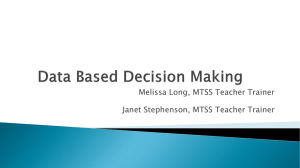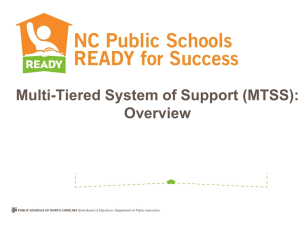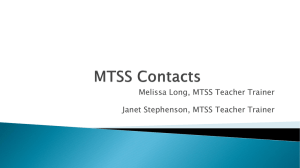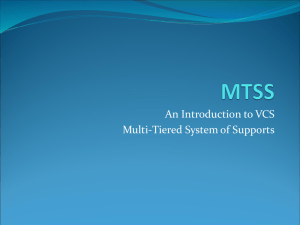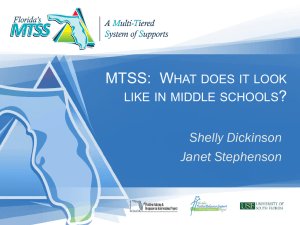Elementary School-wide Progress Monitoring
advertisement
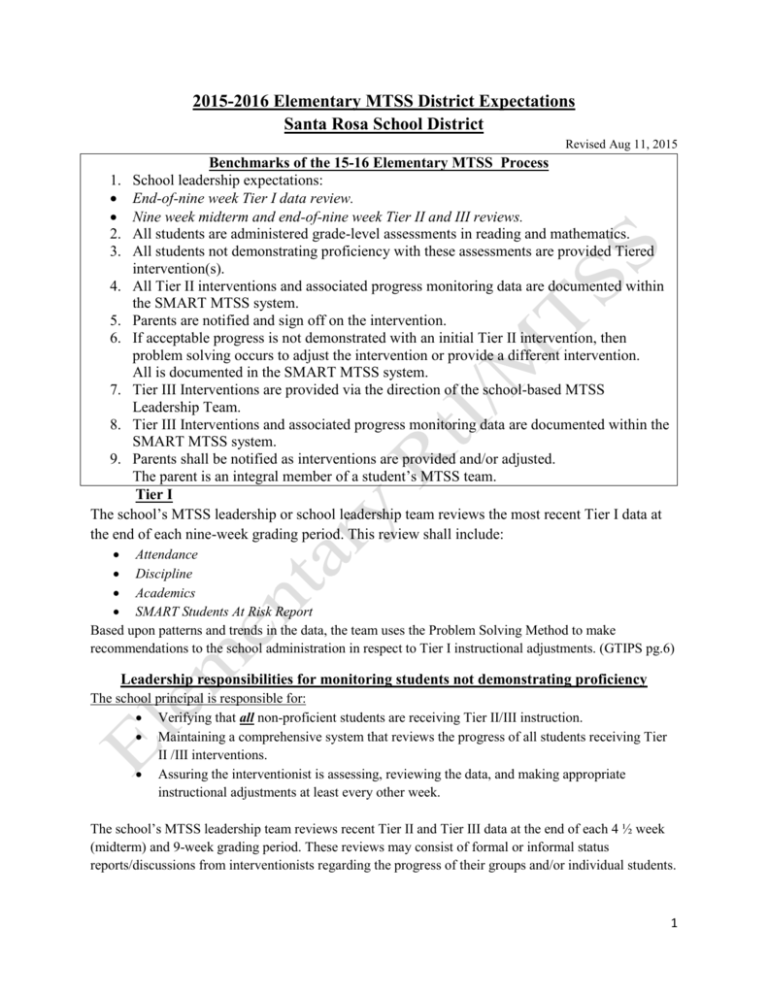
2015-2016 Elementary MTSS District Expectations Santa Rosa School District Revised Aug 11, 2015 Benchmarks of the 15-16 Elementary MTSS Process School leadership expectations: End-of-nine week Tier I data review. Nine week midterm and end-of-nine week Tier II and III reviews. All students are administered grade-level assessments in reading and mathematics. All students not demonstrating proficiency with these assessments are provided Tiered intervention(s). 4. All Tier II interventions and associated progress monitoring data are documented within the SMART MTSS system. 5. Parents are notified and sign off on the intervention. 6. If acceptable progress is not demonstrated with an initial Tier II intervention, then problem solving occurs to adjust the intervention or provide a different intervention. All is documented in the SMART MTSS system. 7. Tier III Interventions are provided via the direction of the school-based MTSS Leadership Team. 8. Tier III Interventions and associated progress monitoring data are documented within the SMART MTSS system. 9. Parents shall be notified as interventions are provided and/or adjusted. The parent is an integral member of a student’s MTSS team. Tier I The school’s MTSS leadership or school leadership team reviews the most recent Tier I data at the end of each nine-week grading period. This review shall include: 1. 2. 3. Attendance Discipline Academics SMART Students At Risk Report Based upon patterns and trends in the data, the team uses the Problem Solving Method to make recommendations to the school administration in respect to Tier I instructional adjustments. (GTIPS pg.6) Leadership responsibilities for monitoring students not demonstrating proficiency The school principal is responsible for: Verifying that all non-proficient students are receiving Tier II/III instruction. Maintaining a comprehensive system that reviews the progress of all students receiving Tier II /III interventions. Assuring the interventionist is assessing, reviewing the data, and making appropriate instructional adjustments at least every other week. The school’s MTSS leadership team reviews recent Tier II and Tier III data at the end of each 4 ½ week (midterm) and 9-week grading period. These reviews may consist of formal or informal status reports/discussions from interventionists regarding the progress of their groups and/or individual students. 1 Tier II Students not demonstrating proficiency for reading and/or mathematics are provided Tier II interventions until proficiency is achieved. A gap analysis is an integral part of the Tier II intervention analysis process. This is a problem-solving discussion on why a gap exists between the student’s data and the data of their peer group. Tier II interventions are delivered to small groups of students at least three days per week. These are documented on the PMP in the SMART MTSS System. Progress monitoring data is collected at least every other week. This is also recorded on the PMP in the SMART MTSS System. During the first nine weeks of school the teacher will conference with all parents of students receiving Tier II interventions. The teacher will provide: Data demonstrating the need for intervention Explanation of intervention Most recent data reflective of intervention results Intervention goal Parent’s role and opportunities for support Signatures are to be secured on the PMP– parent copy- cumulative record copy A note documenting this conference must be placed on the PMP in the SMART MTSS system For students demonstrating a desired rate of progress with a Tier II intervention the teacher may consider fading the intervention to see if the progress can be maintained with only Tier I instruction. However, after a reasonable amount of time, if a student cannot demonstrate acceptable progress with an initial Tier II intervention, the interventionist should problem solve with a designated colleague in accordance with the school’s MTSS process. This might involve a mentor teacher, grade chair, academic coach, AIS, or even the school’s MTSS leadership team. They should review the data and adjust instruction accordingly. NOTE: The involvement of other staff members (MTSS leadership) in reviewing a teacher’s Tier II data is dependent upon the judgment of the interventionist providing the instruction. The parent/guardian must be advised of the rationale and specifics when an intervention is changed. Document notification on the student’s PMP in the SMART MTSS system. If a student cannot demonstrate acceptable progress with a Tier II intervention the following must be considered: a. Did the same intervention improve other students’ performance? Examine fidelity. b. Is the student’s deficiency correctly targeted by this intervention? Review hypothesis. c. Consider intensifying this intervention for a short period of time, providing a different and/or additional Tier II intervention, and/or providing a Tier III intervention. Tier III The MTSS leadership team, including the student’s parent(s), is solely responsible for providing and directing all Tier III interventions. 2 The MTSS leadership team will review all previous intervention data, problem solve, and identify an appropriate Tier III intervention. Tier III interventions are delivered daily to very small groups of students. The interventionist must record weekly assessment data on the student’s PMP in the SMART MTSS system Tier III Interventions are to be documented on the student’s PMP in the SMART MTSS system Print the revised PMP and obtain parent signature. – parent copy This revised, signed PMP and all supporting documentation are to be maintained in an orange folder. At the end of the school year the orange folder, containing the final printed PMP and all supporting documentation, is to be placed into the student’s cumulative file. The MTSS philosophy calls for a consistent review of data to adjust instruction to maintain or increase rates of learning. The goal of MTSS is high school graduation. Every decision must address the question, “Will this increase the probability of this student graduating from high school on time?” Therefore, given that MTSS data is used for some ESE eligibility decisions, any student considered for an IEP must have viable data from at least two distinct Tier III interventions in groups of three or less. Both interventions must have been delivered consecutively, with fidelity, by interventionist(s) trained in each strategy. 3
